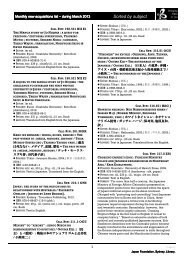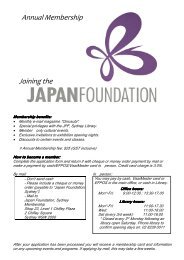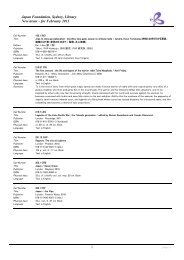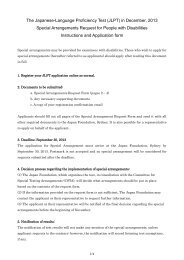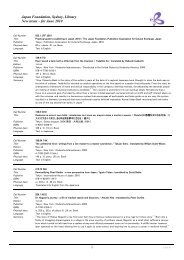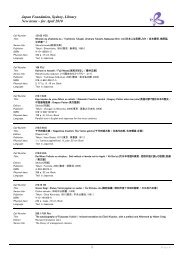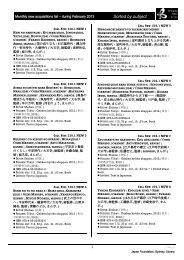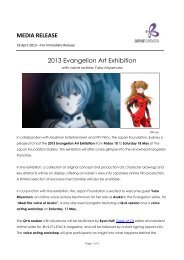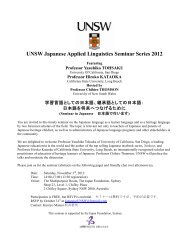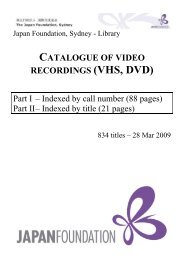catalogue of video recordings (vhs, dvd) - The Japan Foundation
catalogue of video recordings (vhs, dvd) - The Japan Foundation
catalogue of video recordings (vhs, dvd) - The Japan Foundation
You also want an ePaper? Increase the reach of your titles
YUMPU automatically turns print PDFs into web optimized ePapers that Google loves.
<strong>Japan</strong> <strong>Foundation</strong>, Sydney, Library<br />
Video <strong>catalogue</strong> (VHS, DVD) – Indexed by call number<br />
Title: Gasshō-zukuri shūraku, Hiroshima Heiwa Kinenhi <strong>The</strong> Gassho-<br />
zukuri villages & Hiroshima Peace Memorial Monument | [produced by<br />
NHK International].| 合 掌 造 り 集 落 ・ 広 島 平 和 記 念 碑 = <strong>The</strong> gassho-<br />
zukuri villages & Hiroshima Peace Memorial Monument | [produced by<br />
NHK International].|<br />
Publisher: [Tokyo] : NHK International, [200-?]<br />
Physical description: 1 <strong>video</strong>cassette (VHS, PAL) (20 min.) :sd.,<br />
col. ;1/2 in. Video Recording<br />
System requirements: VHS [PAL]<br />
Language: VHS-PAL: Narration in English.<br />
Summary: Along a deeply-carved valley in the mountains <strong>of</strong> central<br />
<strong>Japan</strong> are three picturesque villages with perfectly-preserved gasshozukuri<br />
farmhouses. <strong>The</strong>se wooden structures have steep thatched<br />
ro<strong>of</strong>s that resisit heavy snowfalls. As part <strong>of</strong> the efforts to preserve<br />
these buildings, more than 200 people work together to rethatch one<br />
<strong>of</strong> the larger buildings.<br />
Restriction & Screening notes: Not for Loan. Licensed for public<br />
screening at JF-Sydney<br />
Title: Monokurōmu no yakudō : sumi, jizai no iro = Vivid monochrome :<br />
sumi, colour with wills | [produced by NHK International].|モノクロームの<br />
躍 動 : 墨 ・ 自 在 の 色 = Vivid monochrome : sumi, colour with wills |<br />
[produced by NHK International].|<br />
Publisher: [Tokyo] : NHK International, [200-?].<br />
Physical description: 1 <strong>video</strong>disc (DVD, NTSC) (30 min.) :digital., sd.,<br />
col. ;4 3/4 in. Video Recording<br />
System requirements: VHS [PAL]<br />
Language: Narration in <strong>Japan</strong>ese with English subtitles.<br />
Summary: <strong>Japan</strong>ese ink painting is in one sense simplicity itlself --<br />
black ink (sumi) on white paper. But in the hands <strong>of</strong> a master<br />
artist/calligrapher such as Sakaki Bakuzan, who is featured in this<br />
programme, sumi takes on many shades <strong>of</strong> meaning. As with the great<br />
masters <strong>of</strong> the past, Bakuzan sees monochrome as a challenge rather<br />
than a constraint. Using techniques and materials refined ages ago, he<br />
succeeds in suggesting colour and mood with understated elegance. --<br />
From NHK International TV programme <strong>catalogue</strong>.<br />
Restriction & Screening notes: Not for Loan. Licensed for public<br />
screening at JF-Sydney<br />
Call Number: 713 NHK 3<br />
Title: Gensei kara jōdo e = Discovery <strong>of</strong> the "pure land" | [produced<br />
by NHK International].| 現 世 から 浄 土 へ = Discovery <strong>of</strong> the "pure land"<br />
| [produced by NHK International].|<br />
nal].|<br />
Publisher: [Tokyo?] : NHK International, [200-?].<br />
Physical description: 1 <strong>video</strong>disc (DVD) (45 min.) :sd., col. ;4 3/4 in.<br />
Video Recording<br />
System requirements:DVD (NTSC).<br />
Language: Soundtrack in <strong>Japan</strong>ese with English subtitles.<br />
Summary: "Representing an extremely rare form <strong>of</strong> artistic expression,<br />
the statue <strong>of</strong> Kūya in the Kyoto temple Rokuharamitsuji is regarded as<br />
a masterpiece <strong>of</strong> the Kamakura period. Critic Shūichi Kato sees the<br />
statue as the epitome <strong>of</strong> everyday prayers directed at the Amitabha<br />
Buddha. While looking at new forms <strong>of</strong> sculpture that emerged in<br />
Kamakura-period <strong>Japan</strong>, the programme also examines the<br />
transcendental values <strong>of</strong> this turbulent era and how they influenced<br />
<strong>Japan</strong> in future years." -- from 300 TV PROGRAMMES ON JAPAN.<br />
Restriction & Screening notes: Not for loan. Licensed for public<br />
screening at JF-Sydney<br />
Call Number: 721.025 NHK 8<br />
Title: Gensō ni asobu = Escape into fantasy | [produced by NHK<br />
International].| 幻 想 に 遊 ぶ = Escape into fantasy | [produced by NHK<br />
International].|<br />
Publisher: [Tokyo?] : NHK International, [200-?].<br />
Physical description: 1 <strong>video</strong>disc (DVD) (45 min.) :sd., col. ;4 3/4 in.<br />
Video Recording<br />
System requirements:DVD (NTSC).<br />
Language: Soundtrack in <strong>Japan</strong>ese with English subtitles.<br />
Summary: "A realm <strong>of</strong> monstrous creatures and bizarre gore: the latter<br />
stages <strong>of</strong> the Edo period spawned a wealth <strong>of</strong> artistic fantasy and<br />
creativity. High production values together with an astonishing range <strong>of</strong><br />
themes and styles makes these images comparable to other qorks <strong>of</strong><br />
art that are widely regarded as worldclass. Why were so many<br />
fascination images produced in the late Edo period? <strong>The</strong> programme<br />
investigates this fascination with the macabre in <strong>Japan</strong>ese art, and<br />
makes comparisons with fantasy works from Western Europe." --<br />
from 300 TV PROGRAMMES ON JAPAN.<br />
Restriction & Screening notes: Not for loan. Licensed for public<br />
screening at JF-Sydney<br />
Call Number: 721.3 NHK 4<br />
Title: Suiboku, tenchi no shinshō = <strong>Japan</strong>ese ink painting. a mental<br />
image <strong>of</strong> the world | [produced by NHK International].| 水 墨 ・ 天 地 の 心<br />
象 = <strong>Japan</strong>ese ink painting. a mental image <strong>of</strong> the world | [produced<br />
by NHK International].|<br />
Publisher: [Tokyo?] : NHK International, [200-?].<br />
Physical description: 1 <strong>video</strong>disc (DVD) (45 min.) :sd., col. ;4 3/4 in.<br />
Video Recording<br />
System requirements:DVD (NTSC).<br />
Language: Soundtrack in <strong>Japan</strong>ese with English subtitles.<br />
Summary: "<strong>The</strong>re are parallels between <strong>Japan</strong>ese ink paintings and the<br />
Expessionist paintings <strong>of</strong> early-20th century Europe", claims critic<br />
Shuichi Kato, noting that both traditions attach maximum importance<br />
to expressing an inner world: the mind. He visitd Huabei and Jiangnan,<br />
the cradle <strong>of</strong> Chinese ink painting, and western Germany, the artistic<br />
homeland <strong>of</strong> Kandinsky, searching for similarities and differences in the<br />
traditional cultures <strong>of</strong> these places." -- from 300 TV PROGRAMMES<br />
ON JAPAN.<br />
Restriction & Screening notes: Not for loan. Licensed for public<br />
screening at JF-Sydne<br />
Sydney<br />
Call Number: 721.5 NHK 5<br />
Title: Rinpa, umi o wataru = <strong>The</strong> Rimpa school crosses the ocean |<br />
[produced by NHK International].| 琳 派 ・ 海 を 渡 る = <strong>The</strong> Rimpa school<br />
crosses the ocean [produced by NHK International].|<br />
Publisher: [Tokyo?] : NHK International, [200-?].<br />
Physical description: 1 <strong>video</strong>disc (DVD) (45 min.) :sd., col. ;4 3/4 in.<br />
Video Recording<br />
System requirements:DVD (NTSC).<br />
Language: Soundtrack in <strong>Japan</strong>ese with English subtitles.<br />
Summary: "It's a like-known fact that works <strong>of</strong> the Rimpa School,<br />
which blossomed under gifted painters like Honami Koetsu, Tawaraya<br />
Soatsu, and Ogata Korin, crossed a continent to distant Europe and<br />
had a major impact on the art world there. This programme probes the<br />
source <strong>of</strong> the Rimpa School's aethetic sensebilities and explains its<br />
influence on the background <strong>of</strong> the Art Nouveau movement in kate-<br />
19th century France." -- from 300 TV PROGRAMMES ON JAPAN.<br />
Restriction & Screening notes: Not for loan. Licensed for public<br />
screening at JF-Sydney<br />
Call Number: 721.3 NHK<br />
Call Number: 721.8 NHK 7<br />
36 21-Apr-10



